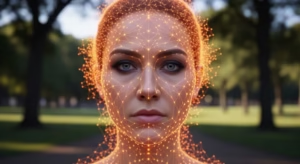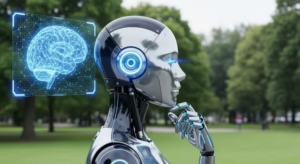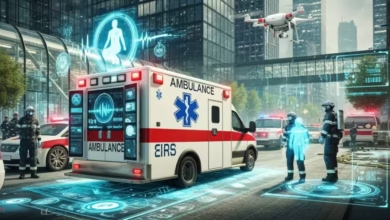AI and Aging: How Technology Is Helping People Live Longer

The blog post titled ‘AI and Aging: How Technology Is Helping People Live Longer’ explores the transformative impact of AI aging technology on longevity. It highlights how this innovative technology aids in predicting age, improving healthcare strategies, and enhancing overall life quality through elder care tech. The article outlines actionable steps individuals can take to leverage AI for better health outcomes and increased longevity. By integrating AI aging technology into daily life and healthcare practices, people can optimize their wellness and potentially extend their lifespans. This comprehensive overview emphasizes the significant role AI plays in addressing the challenges of aging and promotes a proactive approach to health management.
Exploring The Impact Of AI Aging Technology On Longevity

The integration of AI aging technology in healthcare is revolutionizing how we approach the challenges of aging. Advances in this field leverage data analytics and machine learning to enhance our understanding of the biological processes linked to longevity. By analyzing genetic, environmental, and lifestyle factors, these technologies are paving the way for personalized interventions that can significantly extend healthy life spans. As researchers continue to improve algorithms for better accuracy, the potential for practical applications in daily health management becomes increasingly viable.
Key Areas Where AI And Aging Intersect
- Personalized health insights
- Predictive analytics for age-related diseases
- Automation in elder care
- Enhanced drug development for age-related conditions
- Wearable technology for real-time health monitoring
- Community support platforms using AI
As longevity AI makes significant strides, we are beginning to see its ability to forecast potential health issues before they arise. This proactive approach allows healthcare providers to create tailored prevention plans, ultimately enhancing the quality of life for the aging population. The implications of these technologies extend beyond health; they foster a greater sense of autonomy and empowerment among older adults, encouraging healthier lifestyle choices and stronger community connections.
How AI Aging Technology Facilitates Age Prediction And Beyond

As the interest in AI aging technology grows, researchers and developers are increasingly focused on how these innovations can assist in age prediction and related health monitoring. This advanced technology uses complex algorithms and data analysis to assess various physical and physiological characteristics, enabling a more accurate estimation of an individual’s biological age compared to their chronological age. Such capabilities open new avenues for personalized healthcare and preventive measures that can ultimately enhance longevity.
The essence of age prediction lies in its capacity to forecast not just the current state of health, but also potential future ailments. By leveraging health monitoring AI, individuals and healthcare professionals can gain insights into the effects of lifestyle choices on long-term health. For instance, factors such as diet, exercise, and stress levels are analyzed to provide a comprehensive overview of a person’s health trajectory. The integration of AI in age prediction is, therefore, not merely a reactive measure but a proactive approach to wellness.
| Technology | Usage | Benefits |
|---|---|---|
| Machine Learning Algorithms | Analyze large datasets for age prediction | Improved accuracy in health assessments |
| Wearable Devices | Monitor real-time health metrics | Continuous health tracking and data gathering |
| Genomic Sequencing | Identify genetic biomarkers related to aging | Personalized health strategies based on genetic data |
| Health Data Analytics | Process patient data for predictive modeling | Targeted interventions and preventive care |
With these advancements, it’s essential to understand the mechanisms behind AI’s capabilities. It employs both supervised and unsupervised learning techniques, allowing for the classification and clustering of age-related data sets. The better the system knows the data, the more precise the age predictions become. Additionally, AI can continually learn from new data, thus refining its predictions over time and adapting to changes in individual health conditions.
Steps To Implement AI For Age Prediction
- Identify the specific health metrics to monitor.
- Collect data through surveys, wearables, or health records.
- Utilize machine learning algorithms for the analysis of data.
- Validate predictions with clinical or demographic benchmarks.
- Implement regular updates to the model with new data.
- Ensure compliance with data privacy regulations.
- Engage healthcare professionals to interpret results and recommend actions.
By understanding these steps, individuals and healthcare institutions can effectively integrate AI technology into their age prediction practices. The outcome is an enhanced capability to forecast health issues before they manifest, thereby equipping society to tackle the aging phenomenon more intelligently and compassionately.
Real-World Applications of Age Prediction
The real-world implications of AI aging technology extend well beyond theoretical discussions. From healthcare professionals using predictive analytics to manage chronic diseases to fitness enthusiasts tailoring their routines based on AI-generated insights, the applications are vast and varied. Several organizations have begun implementing programs that utilize AI for proactive health monitoring, ensuring individuals receive timely interventions that could change their health trajectories profoundly.
The Role Of Elder Care Tech In Enhancing Quality Of Life

Elder care tech plays a crucial role in significantly improving the quality of life for older adults. As AI aging technology continues to evolve, it becomes increasingly integrated into daily life, facilitating better health management, enhancing social engagement, and promoting independence among seniors. By leveraging these technologies, caregivers can create a more supportive environment that addresses the unique needs of aging individuals, ultimately leading to a more fulfilling and healthier life.
One of the most pivotal aspects of elder care tech is its ability to provide personalized care solutions. These solutions can utilize data to tailor interventions specifically suited to the individual’s health conditions and preferences. Some technologies not only aid in monitoring health but allow older adults to connect socially, combating the loneliness often associated with aging. Strong integration with smart home devices further supports safety, offering peace of mind to both caregivers and family members.
Benefits Of Elder Care Tech
- Enhanced monitoring: Continuous health tracking can promptly identify changes requiring attention.
- Improved medication management: Automated reminders help ensure medication adherence.
- Increased safety: Smart home devices can detect emergencies, alerting responders instantly.
- Social connectivity: Technologies can facilitate virtual social interactions, reducing isolation.
- Accessibility: Devices specifically designed for seniors simplify the use of technology.
- Data-driven insights: AI can analyze patterns to recommend proactive health measures.
Overall, incorporating elder care tech into the lives of seniors provides empowering tools that enhance their independence while ensuring they receive the support they need. As the capabilities of AI aging technology grow, it is likely we will see even more innovative solutions that cater to the dynamic needs of our aging population. By embracing these advancements, we can greatly enrich the quality of life for seniors today.
Types Of Elder Care Technologies
Various types of elder care technologies have emerged, each designed to address specific aspects of elderly care. From telehealth systems that enable remote consultations to wearable health devices that monitor vital signs, the diversity of these tools means that seniors can find supportive technologies tailored to their lifestyles. Additionally, AI aging technology encompasses applications that encourage cognitive engagement through brain games and learning platforms, helping keep mental fitness in check. The ongoing advancements in this field suggest a promising future for elder care and the remarkable potential of technology in maintaining the health and happiness of older adults.
Actionable Steps To Leverage AI For Longevity And Health
As AI aging technology continues to evolve, it is becoming increasingly vital for individuals and organizations to adopt strategies that harness its capabilities for promoting longevity and health. The integration of longevity AI solutions can facilitate personalized health management, optimize wellness, and ultimately extend life expectancy. Moreover, employing health monitoring AI allows for real-time tracking of health metrics, enabling early detection of potential age-related ailments and personalized interventions that can lead to healthier aging.
Essential Strategies For Implementing AI Aging Solutions
- Conduct a thorough assessment of current health needs and objectives.
- Identify suitable AI tools and platforms that address these needs effectively.
- Implement data collection systems for continuous health monitoring.
- Utilize AI analytics to gain insights from the collected health data.
- Develop personalized health plans based on AI recommendations.
- Educate stakeholders on the benefits and functionalities of AI solutions.
- Continuously evaluate and adjust strategies based on feedback and outcomes.
By following these essential strategies, individuals and care providers can leverage the full potential of AI aging technology to not only improve health outcomes but also enhance overall quality of life. Embracing longevity AI offers a proactive approach to aging, providing a robust framework for making informed health decisions and embracing a transformative journey towards extended healthspan.
Briefing Document: The Transformative Impact of AI on Aging and Longevity
This brief explains how AI is revolutionizing healthcare, improving the quality of life for seniors, and offers actionable strategies for leveraging technology to achieve longer life.
I. Main Themes and Core Arguments
The central theme is the transformative impact of AI aging technology on longevity and the quality of life for older adults. The source consistently emphasizes AI’s proactive capabilities in predicting health issues, personalizing care, and empowering individuals.
Key Arguments:
- AI is revolutionizing how we approach aging: It moves beyond reactive care to proactive prevention and personalized interventions.
- AI facilitates accurate age prediction and health monitoring: By analyzing diverse data, AI can estimate biological age and forecast future ailments, allowing for early intervention.
- Elder care tech significantly enhances the quality of life for seniors: It promotes independence, safety, social connectivity, and personalized care.
- Individuals and organizations can leverage AI for better health outcomes and extended lifespans: The source provides actionable steps for implementing AI solutions.
II. Most Important Ideas and Facts
A. Exploring the Impact of AI Aging Technology on Longevity
- Revolutionizing Healthcare: “The integration of AI aging technology in healthcare is revolutionizing how we approach the challenges of aging.”
- Personalized Interventions: AI “leverage data analytics and machine learning to enhance our understanding of the biological processes linked to longevity. By analyzing genetic, environmental, and lifestyle factors, these technologies are paving the way for personalized interventions that can significantly extend healthy life spans.”
- Proactive Approach: “As longevity AI makes significant strides, we are beginning to see its ability to forecast potential health issues before they arise. This proactive approach allows healthcare providers to create tailored prevention plans.”
- Empowerment and Autonomy: AI fosters “a greater sense of autonomy and empowerment among older adults, encouraging healthier lifestyle choices and stronger community connections.”
Key Areas Where AI and Aging Intersect:
- Personalized health insights
- Predictive analytics for age-related diseases
- Automation in elder care
- Enhanced drug development for age-related conditions
- Wearable technology for real-time health monitoring
- Community support platforms using AI
B. How AI Aging Technology Facilitates Age Prediction and Beyond
- Biological vs. Chronological Age: AI “uses complex algorithms and data analysis to assess various physical and physiological characteristics, enabling a more accurate estimation of an individual’s biological age compared to their chronological age.”
- Forecasting Future Ailments: The “essence of age prediction lies in its capacity to forecast not just the current state of health, but also potential future ailments.”
- Lifestyle Impact: “By leveraging health monitoring AI, individuals and healthcare professionals can gain insights into the effects of lifestyle choices on long-term health. For instance, factors such as diet, exercise, and stress levels are analyzed to provide a comprehensive overview of a person’s health trajectory.”
- Continuous Learning: “AI can continually learn from new data, thus refining its predictions over time and adapting to changes in individual health conditions.”
Technologies and Their Benefits in Age Prediction:
- Machine Learning Algorithms: Analyze large datasets for age prediction, leading to improved accuracy in health assessments.
- Wearable Devices: Monitor real-time health metrics, enabling continuous health tracking and data gathering.
- Genomic Sequencing: Identify genetic biomarkers related to aging, allowing for personalized health strategies.
- Health Data Analytics: Process patient data for predictive modeling, resulting in targeted interventions and preventive care.
Steps to Implement AI for Age Prediction:
- Identify specific health metrics.
- Collect data (surveys, wearables, health records).
- Utilize machine learning algorithms for analysis.
- Validate predictions.
- Implement regular model updates.
- Ensure data privacy compliance.
- Engage healthcare professionals for interpretation and action.
C. The Role of Elder Care Tech in Enhancing Quality of Life
- Personalized Care Solutions: Elder care tech “can utilize data to tailor interventions specifically suited to the individual’s health conditions and preferences.”
- Combating Loneliness: Technologies “not only aid in monitoring health but allow older adults to connect socially, combating the loneliness often associated with aging.”
- Increased Independence and Safety: “Strong integration with smart home devices further supports safety, offering peace of mind to both caregivers and family members.”
Benefits of Elder Care Tech:
- Enhanced monitoring: Continuous health tracking.
- Improved medication management: Automated reminders.
- Increased safety: Smart home devices detect emergencies.
- Social connectivity: Facilitates virtual interactions.
- Accessibility: Devices designed for seniors.
- Data-driven insights: AI analyzes patterns for proactive measures.
Types of Elder Care Technologies:
- Telehealth systems for remote consultations.
- Wearable health devices for vital sign monitoring.
- AI aging technology for cognitive engagement (brain games, learning platforms).
D. Actionable Steps to Leverage AI for Longevity and Health
- Personalized Health Management: The integration of “longevity AI solutions can facilitate personalized health management, optimize wellness, and ultimately extend life expectancy.”
- Early Detection: Employing “health monitoring AI allows for real-time tracking of health metrics, enabling early detection of potential age-related ailments and personalized interventions.”
Essential Strategies for Implementing AI Aging Solutions:
- Assess current health needs.
- Identify suitable AI tools.
- Implement data collection systems.
- Utilize AI analytics for insights.
- Develop personalized health plans based on AI recommendations.
- Educate stakeholders.
- Continuously evaluate and adjust strategies.
The source paints a highly optimistic picture of AI’s role in addressing the challenges of aging. It highlights AI’s capacity to move beyond traditional reactive healthcare models, fostering a proactive, personalized, and empowering approach to health and longevity. By integrating AI aging technology into daily life and healthcare practices, the future promises extended healthspans and a significantly enhanced quality of life for the aging population.
For similar articles, please visit: AI in Healthcare & Medicine
Homepage / humanaifuture.com
🎧 Listen to the Podcast
Want to explore this topic in more depth? Listen to the full podcast for more insights and expert commentary.
▶️ Play on Google DriveNo sign-up needed — just click and listen.
What are the key areas where AI and aging intersect?
The intersection of AI and aging spans several critical areas: personalized health insights, predictive analytics for age-related diseases, automation in elder care, enhanced drug development for age-related conditions, wearable technology for real-time health monitoring, and community support platforms utilizing AI. These applications work together to promote healthier lifestyle choices, stronger community connections, and greater autonomy for older adults.
How does AI aging technology facilitate age prediction?
AI aging technology uses complex algorithms and data analysis to assess various physical and physiological characteristics, providing a more accurate estimation of an individual's biological age compared to their chronological age. This capability is crucial for forecasting future ailments by analyzing factors like diet, exercise, and stress levels. AI employs both supervised and unsupervised learning techniques to classify and cluster age-related datasets, continually refining its predictions over time as it learns from new data.
What are some real-world applications of AI aging technology?
The real-world applications of AI aging technology are extensive. Healthcare professionals utilize predictive analytics to manage chronic diseases, while fitness enthusiasts tailor routines based on AI-generated insights. Organizations are implementing programs for proactive health monitoring, ensuring timely interventions that can profoundly alter health trajectories. This technology is not just theoretical but actively employed to improve health outcomes across various sectors.
How does elder care tech enhance the quality of life for older adults?
Elder care tech significantly improves the quality of life for older adults by integrating AI aging technology into daily life, facilitating better health management, enhancing social engagement, and promoting independence. It provides personalized care solutions, aids in continuous health monitoring, improves medication management, increases safety through smart home devices, fosters social connectivity, and offers data-driven insights for proactive health measures. These technologies empower seniors while ensuring they receive necessary support.
What specific benefits does elder care tech offer?
Elder care tech offers several key benefits: enhanced monitoring for prompt identification of health changes, improved medication management through automated reminders, increased safety via smart home devices that detect emergencies, social connectivity to reduce isolation, accessibility through senior-friendly device designs, and data-driven insights from AI analysis for proactive health recommendations.
What actionable steps can individuals take to leverage AI for longevity and health?
Individuals can take several actionable steps: conduct a thorough assessment of current health needs, identify suitable AI tools and platforms, implement data collection systems for continuous monitoring, utilize AI analytics to gain insights from collected data, develop personalized health plans based on AI recommendations, and continuously evaluate and adjust strategies based on feedback and outcomes. These steps help individuals harness AI's full potential for better health outcomes and an enhanced quality of life.
What types of elder care technologies are emerging?
A diverse range of elder care technologies is emerging, including telehealth systems for remote consultations, wearable health devices for monitoring vital signs, and AI aging applications that encourage cognitive engagement through brain games and learning platforms. These tools are designed to address specific aspects of elderly care, supporting mental fitness, health maintenance, and overall happiness for older adults.




